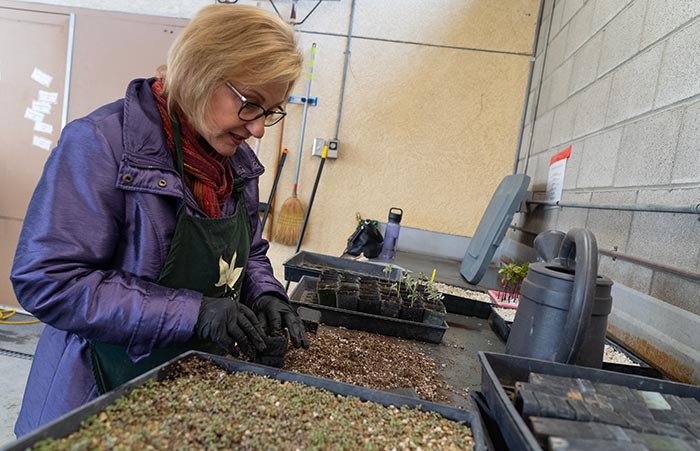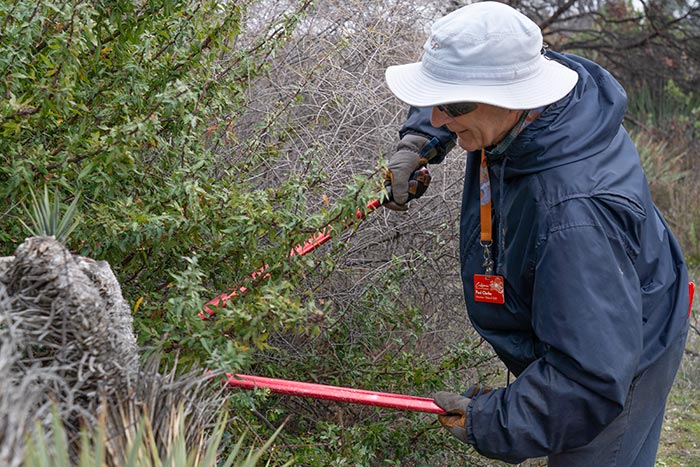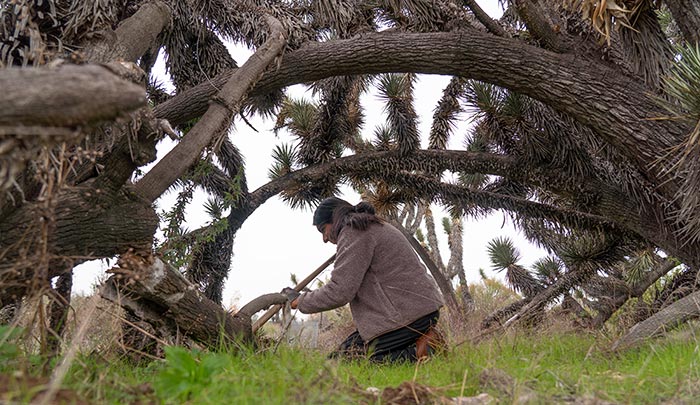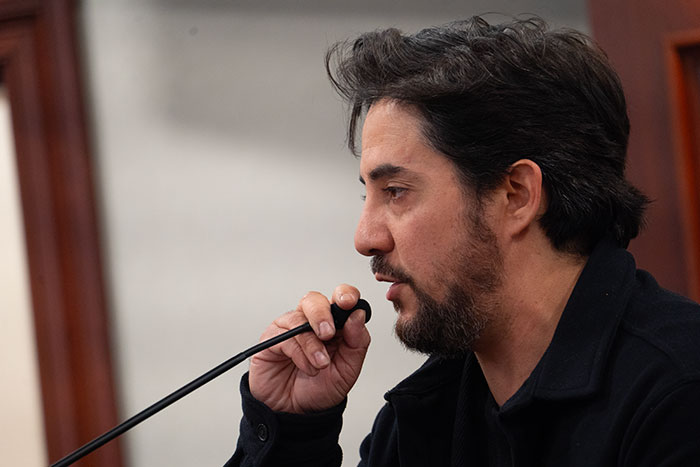CalBG offers many opportunities for volunteering

Volunteer Ingrid Spiteri moves saplings and seeds to individual pots last week at CalBG’s grow native nursery. Courier photo/Andrew Alonzo
by Andrew Alonzo | aalonzo@claremont-courier.com
From hard labor like pulling weeds, to cataloging at the herbarium, to overseeing seeds and sprouts at the grow native nursey, California Botanic Garden volunteers keep the nonprofit going — and looking its best.
“I think they’re crucial,” said CalBG Volunteer Organization Coordinator Patty Nueva Espana. “I don’t think the garden can do it without having volunteers to help out.”
Nueva Espana noted there are numerous opportunities to get involved, including work with the production nursery, the California seed bank, coordinating events, leading garden tours, as well as the bench and leaf brigade, a group that maintains CalBG’s many benches and paths. Claremont resident and herbarium volunteer Lisa McCarter, 65, said volunteers need not have deep knowledge about plants to get involved, as staff teach the ins and outs of the various programs.

Volunteer Paul Clarke snips weeds that had wrapped around a Joshua tree last week at CalBG. Courier photo/Andrew Alonzo
Volunteers
Every Wednesday and select Saturday mornings, volunteers on CalBG’s grounds work crew assist staff with weeding, pruning and planting around the garden.
Claremont resident Tom White, 61, once a frequent walker of the garden, decided about 35 years ago to begin volunteering. He calls the outdoor work an “enriching experience” that has improved both his mental and physical well-being. Another grounds crew volunteer, Sharron Chalmers, echoed White and said the landscape and volunteer community keep her coming back.
“It keeps you grounded,” said the 68-year-old Glendora resident. “I told my husband the other day, ‘I got to go.’ I’m feeling stressed out when we didn’t go to it [recently] because it was raining and everything. And I’m going, ‘I just need it.’ It’s just something I look forward to every week.”

(L-R) Volunteers Ray Owens, Paul Standerfer (in cart), Paul Clarke, Emy Weller, and CalBG Volunteer Coordinator Patty Nueva Espana are pictured last week at the garden. Courier photo/Andrew Alonzo
Like White, Claremonter Paul Standerfer, 68, is a former CalBG walker turned grounds crew volunteer. He began in 2021 and takes pride in seeing how his efforts improve the land.
“To be able to see an area that you worked on in the spring and what it looks like in the summer, and the fall, and then you come back around next year and you go, ‘Oh my gosh look at that plant.’ You really feel attached,” Standerfer said.
Avid bird watcher Paul Clarke began volunteering in 2021. The 69-year-old weeds and helps out in the grow native nursery.
“It is kind of good for your health,” he said. “If you were happen to have some issues going on for whatever reason, like if you’re just stressed about the world, three hours on a Wednesday morning here just clears you up. There’s never anything adding to your stress.” Clarke buys into the idea that the garden is a circle of life and added that knowing about native plants helps one understand the effects of climate change.

CalBG volunteer Patricia Brooks works at the herbarium. Courier photo/Andrew Alonzo
Inside the herbarium, helpers work weekly to bind decades-old plant life to filing sheets. The ultimate goal is to create an online searchable catalog for the various global species volunteers said.
“The main thing is to display the plant for the researcher,” said Studio City resident Barbara Booth, an 82-year-old CalBG volunteer since 2006. “These will be scanned and imaged and available online in high resolution …”
Amazingly, plant samples at the herbarium date as far back as 1767.
“People don’t know about this place and that’s why I think, for me, I enjoy working here,” said Pomonan Patricia Brooks, 74. “Not only the family that we have, but trying to do something to keep these specimens alive.”
Volunteers at CalBG’s grow native retail nursery carefully plant specimens into individual soil pots and inventory the space. Ingrid Spiteri, 76, of Rancho Cucamonga, was on hand last Wednesday. She began volunteering at CalBG about 12 years ago.
“As a single person, it gets me out and makes me feel like my life has a meaning to it,” she said. “I enjoy plants and I feel like I’m kind of giving back to nature.”
Benefits of gardening
A study conducted by researchers at University of Colorado Boulder from 2017 to 2019 split 291 non-gardening adults into two groups: 145 were assigned to a community gardening group that received a plot, seeds and seedlings, and an introductory gardening course, and were asked to garden for a year. The other 146, the control group, were asked to wait about a year before touching soil.

Horticulturist Alex Reyes has a go at some weeds wrapped around a Joshua tree last week at CalBG. Courier photo/Andrew Alonzo
The two groups wore activity monitors and were surveyed about their nutrition intake, mental health, and body measurements. The findings, published last year at thelancet.com, showed those in the gardening group ate more fiber than the control group, increased their weekly physical activity levels, and displayed decreased stress and anxiety.
While results don’t tell the entire story, the study was an indicator that gardening can help one both physically and mentally. So, if volunteering is one of your New Year’s resolutions, getting your hands dirty at the California Botanic Garden, 1500 N. College Ave., Claremont, could yield some benefits. Information is available at calbg.org by clicking the volunteer tab.










0 Comments